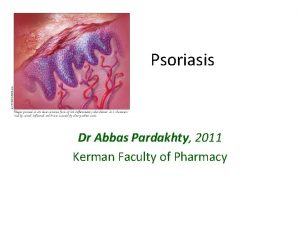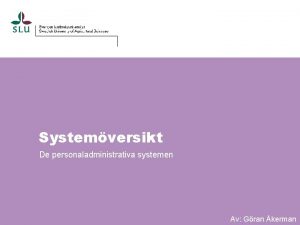IN THE NAME OF GOD Kerman University of



























- Slides: 27

IN THE NAME OF GOD Kerman University of Mahla Medical Sciences satarzadeh

Artificial Blood is a bad news for vampires…

Artificial Blood Substitutes

Introduction Being alive is impossible without blood, the complex liquid containing millions of chemicals and cells. When William Harvey for the first time described blood circulation, scientists started to think about a proper replacement such as an artificial blood.

In 1616 William Harvey described the circulation of blood Ø Ø In 1665 In 1854 In 1883 In 1909 the first blood transfusion on dog by Richard Lower. patients were injected with milk to treat Asiatic cholera. there was a creation of Ringer's solution. Karl Landsteiner classified human blood into four different groups Ø During World War I, galactoso-gluconic acid was used to extend plasma Ø During World War II, human plasma was used to replace blood. Ø In 1947 establishment of blood banks by the American Red Cross.

In 1966, experiments with mice suggested a new type of blood substitute, perfluorocarbons (PFCs). during the Vietnam conflict: This prompted some researchers to begin looking for hemoglobin solutions

Artificial blood was highlighted after emergence of HIV in 1980 due to the risk of its transmission by blood transfusion: ühigher costs due to the necessary detection tests ülow blood supplies especially in developing countries ülower number of donors due to the aging of population üconsequently increased demand for blood products üshort storage period üand urgent needs for blood supplies during wartime and natural disasters

The 21 st century is challenging for human beings: Ø Increased population growth population aging Ø generation of new infectious agents Ø and natural disasters are some threatening factors for the current state of blood transfusion. Ø

Advantages of RBC substitutes ability to transport oxygen and carbon dioxide Ø Low cost Ø no need for crossmatching and blood typing Ø lack of contamination and infectious agents Ø Easy access Ø trouble-free storage conditions Ø extended half-life in circulation Ø full excretion from body and being not accumulated in various tissues Ø lack of toxicity, nonimmunogenicity, nonantigenicity, and noncarcinogenicity Ø

Types of blood substitute: 1. Plasma expander: Colloid Ø Ø Gelatin risk of anaphylaxis Dextran decrease blood viscosity Hydroxyethyl Starch (HES) Albumins and Purified Protein Derivatives Crystalloids Perfluorochemical-based RBC substitutes 2. oxygen carriers Hb-based RBC substitutes

O 2 Carriers…

RBC substitutes or synthetic oxygen transporters studied so far are of mainly two types: v Perfluorochemical-based RBC substitutes Hb-based RBC substitutes Hb-based oxygen carriers (HBOCs) Perfluorocarbons (PFCs)

Perfluorocarbons The capacity of PFCs in carrying oxygen was demonstrated for the first time by Clark in 1966.

Advantages of PFC emulsions v Cheap and easy to manufacture in large quantities v Can be stored at room temperature for more than 1 year v Can be mixed safely with any blood group without the need to check first v The molecules are smaller than red blood cells, allowing them to bypass arterial blockages and penetrate small capillaries with ease, delivering oxygen to areas which need it most

Repeated doses may cause hepatic engorgement Decrease platelet count Impaired neutrophil function Allergy Adverse Effects Of PFC Retained in RE system Early: Headache • Late: Flu like sympto ms

Oxygent. TM Alliance pharmaceuticals (USA) Discontinued Oxycyte. TM Oxygen biotherapeutics (USA) Discontinued PHER-O 2 TM Sanguine Corp (USA) In research Perftoran. TM PERFTORAN (Russia) Approved in Russian clinical application.

Fluosol-DATM Perftoran. TM

The Hb-based oxygen carriers (HBOCs)

Sources of Haemoglobin Highlevel production of recombinant Hb using simple Escherichia coli expression system has been reported by Hoffman et in 1990.

The Hb-based oxygen carriers (HBOCs) are divided into the following two groups: Acellular


Read y to use Immediatel y offloads oxygen No prior planning Faster & better O 2 distribution Benefits of HBOCs Universall y compatible No refrigeration Long shelf life

Vasoactivity hypertension Renal effects Neurotoxicity Gastrointestinal side effects Side effects of HBOCs Platelet aggregation Pancreatic and liver enzyme elevation Antigenicity Cardiac involvement

controversy • Blood substitutes may be misused as performance-enhancing drugs. • Doctors abandoned the use of Hem. Assist. TM in the United States, after patients who received the HBOC died more often than those who received donated blood. • Haemoglobin-based blood substitutes may increase the odds of deaths and heart attacks

Other Promising Technique: RBCs Differentiated From Stem Cells To date, the use of red blood cells (RBCs) produced from stem cells in vitro has not proved for routine transfusion

Conclusion ü In fact, production of a liquid that mimics all blood functions is still a dream. ü However, although many important steps have been taken to date, no oxygencarrying blood substitutes are approved for use by the US FDA. ü Side effects and short half-life are the two main reasons that they did not met criteria for being approved. ü Hence, by considering the first steps that have been taken successfully toward this ideal product, it would be expected in the near future to have a source of required RBCs with minimum complications and maximum similarity to replace RBCs derived from donated blood.

Thank you Tha nks fo r
 Gül kerman
Gül kerman Mhrs kurum
Mhrs kurum Boverket ka
Boverket ka Name all the rays
Name all the rays Hát kết hợp bộ gõ cơ thể
Hát kết hợp bộ gõ cơ thể Slidetodoc
Slidetodoc Bổ thể
Bổ thể Tỉ lệ cơ thể trẻ em
Tỉ lệ cơ thể trẻ em Gấu đi như thế nào
Gấu đi như thế nào Glasgow thang điểm
Glasgow thang điểm Chúa sống lại
Chúa sống lại Môn thể thao bắt đầu bằng chữ f
Môn thể thao bắt đầu bằng chữ f Thế nào là hệ số cao nhất
Thế nào là hệ số cao nhất Các châu lục và đại dương trên thế giới
Các châu lục và đại dương trên thế giới Công thức tính độ biến thiên đông lượng
Công thức tính độ biến thiên đông lượng Trời xanh đây là của chúng ta thể thơ
Trời xanh đây là của chúng ta thể thơ Mật thư tọa độ 5x5
Mật thư tọa độ 5x5 101012 bằng
101012 bằng Phản ứng thế ankan
Phản ứng thế ankan Các châu lục và đại dương trên thế giới
Các châu lục và đại dương trên thế giới Thể thơ truyền thống
Thể thơ truyền thống Quá trình desamine hóa có thể tạo ra
Quá trình desamine hóa có thể tạo ra Một số thể thơ truyền thống
Một số thể thơ truyền thống Cái miệng bé xinh thế chỉ nói điều hay thôi
Cái miệng bé xinh thế chỉ nói điều hay thôi Vẽ hình chiếu vuông góc của vật thể sau
Vẽ hình chiếu vuông góc của vật thể sau Biện pháp chống mỏi cơ
Biện pháp chống mỏi cơ đặc điểm cơ thể của người tối cổ
đặc điểm cơ thể của người tối cổ Thế nào là giọng cùng tên? *
Thế nào là giọng cùng tên? *
















































